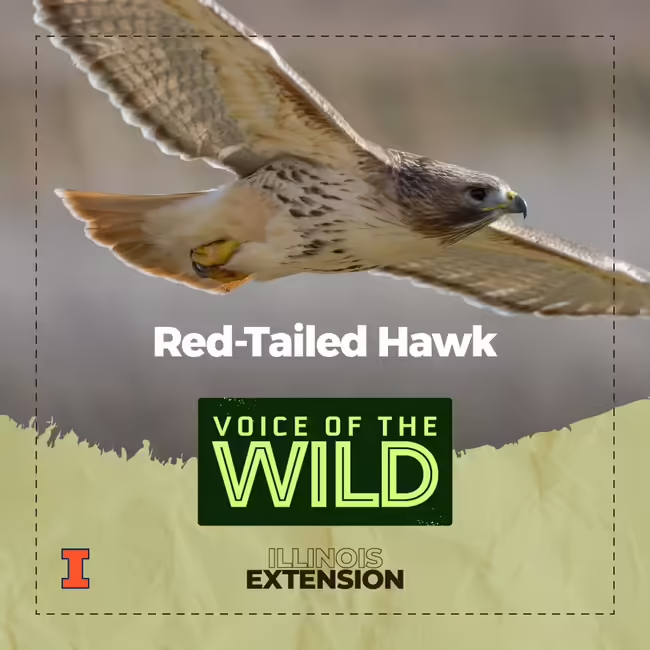
Episode Number
36
Episode Show Notes / Description
Red-tailed hawk (Buteo jamaicensis).
One of the largest and most common raptors in North America and a common sight along highways, especially in winter.
Do you want to learn more bird songs, frog calls, and insect noises? Join Voice of the Wild every Friday to explore a new wild voice. We’re available on most podcast platforms, including Apple Podcasts, Spotify, and YouTube.
Subscription links Here
Subscribe to the Newsletter
Listen online on our Homepage
The following Cornell Lab | Macaulay Library recordings were used in this episode:
- Red-tailed hawk first call by Leonard J. Peyton and Gerald Shields (ML506024)
- Red-tailed hawk second call by Thomas G. Sander (ML506027)
Sources and more:
- https://www.allaboutbirds.org/guide/Red-tailed_Hawk
- https://www.audubon.org/field-guide/bird/red-tailed-hawk
- Dunne P, Sibley D, Sutton C. 2012. Hawks in flight : the flight identification of North American raptors. 2nd ed. Boston: Houghton Mifflin Harcourt.
- Kanter R. 2016 Nov 17. Raptor watching in winter. Illinois Public Media. Available from https://will.illinois.edu/environmentalalmanac/program/raptor-watching-in-winter.
- National Audubon Society videoguide to the birds of North America. 2004. Fullscreen. Carrboro, NC: Godfrey-Stadin Productions.
- Sibley D. 2016. Sibley birds East : field guide to birds of eastern North America. Second edition. New York: Alfred A. Knopf (Field guide to birds of eastern North America).
Transcript
This is Illinois Extension’s Voice of the Wild. A new wild voice in just a moment, so find someplace quiet, take a deep breath, and enjoy.
Hollywood often uses this bird’s fierce screech as a substitute for the whimpy gull-like like call of the bald eagle, in reality the screech belongs to one of America's biggest and most common hawks. They’re present year round but their population concentrates in the states in the winter, that’s when our resident birds are joined by migrants from farther north. They’re often seen perching on power poles and interstate signs where they inspect the surrounding landscape for voles, snakes, rabbits, and other little creatures they’d be happy to eat.
This is the red-tailed hawk (Buteo jamaicensis) from the hawk family Accipitridae
While there are many color morphs of the red-tailed hawk spread across North America, in the midwest we’re most likely to encounter the lighter varieties; these have paler bodies with a distinct dark belly band. In flight you can look for a dark tinge to the leading edge of the wing and of course the red tail; but be warned; Though most people know this hawk because of its eponymous red tail…only the adults have that trait, at least in full. Juvenile birds have paler tails and sometimes tails with no red at all. Here’s the red tailed hawk again.
Thank you to the Macaulay library at the Cornell lab for our bird sounds. And thank you for tuning in to learn a new wild voice with Illinois Extension.
Hollywood often uses this bird’s fierce screech as a substitute for the whimpy gull-like like call of the bald eagle, in reality the screech belongs to one of America's biggest and most common hawks. They’re present year round but their population concentrates in the states in the winter, that’s when our resident birds are joined by migrants from farther north. They’re often seen perching on power poles and interstate signs where they inspect the surrounding landscape for voles, snakes, rabbits, and other little creatures they’d be happy to eat.
This is the red-tailed hawk (Buteo jamaicensis) from the hawk family Accipitridae
While there are many color morphs of the red-tailed hawk spread across North America, in the midwest we’re most likely to encounter the lighter varieties; these have paler bodies with a distinct dark belly band. In flight you can look for a dark tinge to the leading edge of the wing and of course the red tail; but be warned; Though most people know this hawk because of its eponymous red tail…only the adults have that trait, at least in full. Juvenile birds have paler tails and sometimes tails with no red at all. Here’s the red tailed hawk again.
Thank you to the Macaulay library at the Cornell lab for our bird sounds. And thank you for tuning in to learn a new wild voice with Illinois Extension.